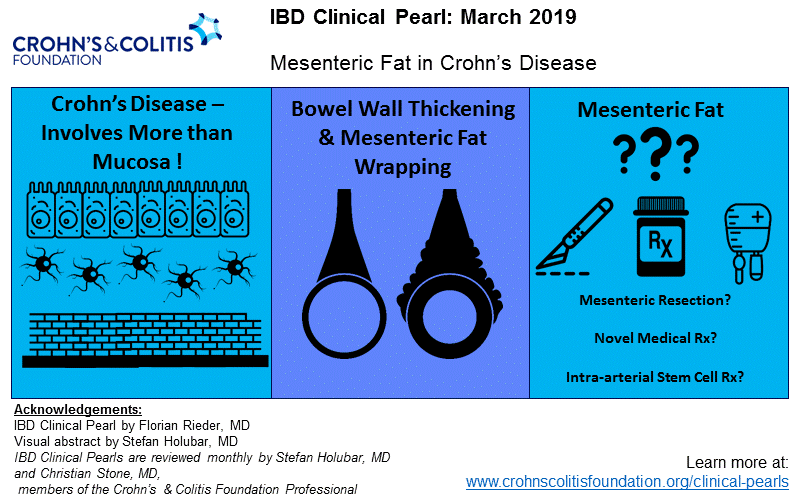Mesenteric Fat in Crohn’s Disease
Florian Rieder, MD, Cleveland Clinic, OH, USA

Accumulating evidence suggests a connection between changes in the mesenteric fat and inflammatory intestinal diseases including IBD, in particular Crohn’s disease 1-4. Anatomically the mesenteric fat is directly connected with the intestinal serosa and muscularis propria and is continuous along the axis of most of the small and large bowel 5, 6. Mesenteric fat wrapping around the circumference of the intestine, so called “creeping fat,” is pathognomonic of CD 1, 7. It sometimes covers more than 50% of the bowel. Recently, the mesenteric and creeping fat in Crohn’s disease has been implicated in its pathogenesis. It contains not only fat cells and their precursors, but also immune cells and non-immune cells, such as endothelial cells and fibroblasts8. These cell types are activated and creeping fat is now known to be an active participant in inflammation and immunity15.
Clinically there is an overlap between intestinal and mesenteric changes on a histopathologic and radiologic level. Mucosal, transmural, serosal and mesenteric alterations are coupled and in the transition zone from normal to abnormal segments all tissue layers change in parallel. This could explain in part the typical transmural nature of the disease 9. Furthermore, creeping fat is associated with muscularis propria hyperplasia and stricturing disease10.
Currently, no mesenteric fat targeted therapies exist, but accumulating evidence suggests that modulation of mesenteric fat mass may influence disease. In a small retrospective study increased visceral fat area was associated with attenuated mucosal healing after anti-TNF therapy in biologically naïve Crohn’s disease patients11. Visceral adiposity as measured by visceral adipose tissue volume may influence the natural history of disease as shown by an association of increased fat with an increased risk of penetrating disease and surgery in CD12. Mesenteric fat may influence the perioperative setting as well. Fat subtype and distribution (subcutaneous-to-visceral fat volume ratio) were found to be predictive of postoperative infectious complications after bowel resection for CD13. Visceral adiposity on cross sectional imaging was found to be an independent risk factor for endoscopic recurrence in post-operative Crohn’s disease14.
The questions remains, does the modulation of mesenteric fat affect outcome? In an excellent study by Coffey et al. surgical recurrence rates after ileocolonic resection for Crohn’s disease were evaluated. In patients with more extensive excision of the mesentery compared to patients with conventional ileocolic resection with limited mesenteric resection the cumulative reoperation rates were 2.9% and 40% respectively. Advanced mesenteric disease predicted increased surgical recurrence15. Interestingly, once present, creeping fat does not seem to change with anti-inflammatory therapy, at least in the short term. Despite endoscopic or transmural healing on MRE, creeping fat was unchanged pre- and post-treatment with anti-TNF therapy or autologous hematopoietic stem-cell transplantation16.
While compelling data is accumulating, at this time it is premature to include radiologic or surgical findings of mesenteric changes as a factor into clinical decision making. Future studies should focus on specific features of CD that are strongly associated with changes in the mesentery 17. Special emphasis should be put on further evaluation of the impact of mesenteric and creeping fat on the response to therapy and natural history of disease, and ultimately its relevance will need to be tested in prospective intervention studies.
References
1. Coffey JC, O'Leary DP. The mesentery: structure, function, and role in disease. Lancet Gastroenterol Hepatol 2016;1:238-247.
2. Desmreumaux P, Ernst, O., Geboes, K., et al. Inflammatory alterations in mesenteric adipose tissue in Crohn's disease. . Gastroenterology 1999;117:73-81.
3. Schaffler A, Herfath, H. Creepiong fat in Crohn's disease: traveling in a creeper lane of research? Gut 2005:742-743.
4. Kredel LI, Siegmund B. Adipose-tissue and intestinal inflammation - visceral obesity and creeping fat. Front Immunol 2014;5:462.
5. Coffey JC, O'Leary D P. Defining the mesentery as an organ and what this means for understanding its roles in digestive disorders. Expert Rev Gastroenterol Hepatol 2017;11:703-705.
6. Coffey JC, Kiernan, M., Walsh, L.G. Histology of the mesentery. In: Coffey JC, ed. Mesenteric Principles of Gastrointestinal Surgery: Basic and Applied Science. Volume 1. Boca Raton, Florida, USA: CRC Press, Taylor and Francis Group, 2017:47-56.
7. Crohn BB, Ginzburg L, Oppenheimer GD. Landmark article Oct 15, 1932. Regional ileitis. A pathological and clinical entity. By Burril B. Crohn, Leon Ginzburg, and Gordon D. Oppenheimer. JAMA 1984;251:73-9.
8. Mao R, Kurada S, Gordon IO, et al. The Mesenteric Fat and Intestinal Muscle Interface: Creeping Fat Influencing Stricture Formation in Crohn's Disease. Inflamm Bowel Dis 2018.
9. Coffey JC, O'Leary DP, Kiernan MG, et al. The mesentery in Crohn's disease: friend or foe? Curr Opin Gastroenterol 2016;32:267-73.
10. Borley NR, Mortensen NJ, Jewell DP, et al. The relationship between inflammatory and serosal connective tissue changes in ileal Crohn's disease: evidence for a possible causative link. J Pathol 2000;190:196-202.
11. Shen W, Cao L, Li Y, et al. Visceral Fat Is Associated With Mucosal Healing of Infliximab Treatment in Crohn's Disease. Dis Colon Rectum 2018;61:706-712.
12. Van Der Sloot KW, Joshi AD, Bellavance DR, et al. Visceral Adiposity, Genetic Susceptibility, and Risk of Complications Among Individuals with Crohn's Disease. Inflamm Bowel Dis 2017;23:82-88.
13. Stidham RW, Waljee AK, Day NM, et al. Body fat composition assessment using analytic morphomics predicts infectious complications after bowel resection in Crohn's disease. Inflamm Bowel Dis 2015;21:1306-13.
14. Holt DQ, Moore GT, Strauss BJ, et al. Visceral adiposity predicts post-operative Crohn's disease recurrence. Aliment Pharmacol Ther 2017;45:1255-1264.
15. Coffey CJ, Kiernan MG, Sahebally SM, et al. Inclusion of the Mesentery in Ileocolic Resection for Crohn's Disease is Associated With Reduced Surgical Recurrence. J Crohns Colitis 2018;12:1139-1150.
16. Rimola J, Alfaro I, Fernandez-Clotet A, et al. Persistent damage on magnetic resonance enterography in patients with Crohn's disease in endoscopic remission. Aliment Pharmacol Ther 2018;48:1232-1241.
17. Sahebally SM, Burke JP, Chang KH, et al. Circulating fibrocytes and Crohn's disease. Br J Surg 2013;100:1549-56.